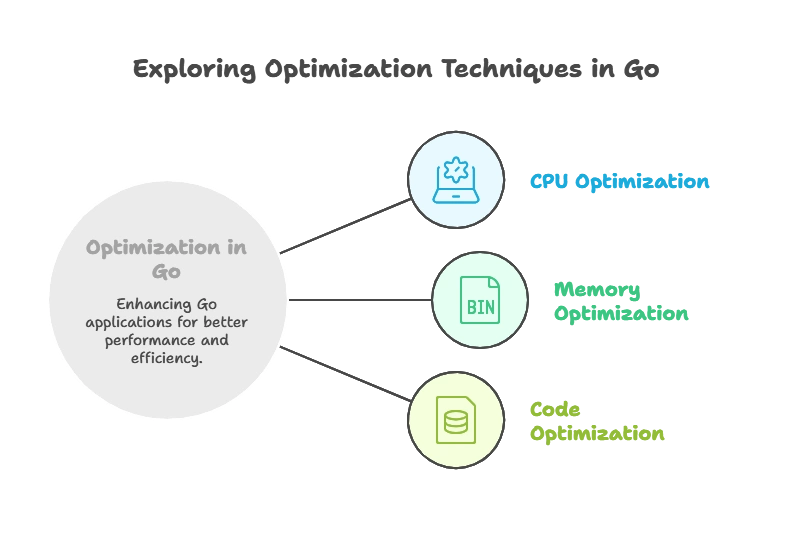Optimization Techniques
Optimization techniques play a crucial role in enhancing the performance and efficiency of Go applications. This chapter explores a comprehensive range of optimization techniques, from basic to advanced, providing developers with the knowledge and tools needed to optimize their Go code effectively.
Understanding Optimization Basics
Basic Concepts
Optimization involves improving the performance, efficiency, and resource usage of software applications. In Go, optimization can target various aspects such as execution speed, memory usage, and code size.
Types of Optimization
Optimization techniques in Go can be broadly categorized into CPU optimization, memory optimization, and code optimization. Each type focuses on different aspects of application performance.

CPU Optimization Techniques
Loop Optimization
Loop optimization involves optimizing loops to minimize iteration overhead and improve execution speed. Techniques such as loop unrolling, loop fusion, and loop vectorization can enhance loop performanc
// Before optimization
func sum(n int) int {
result := 0
for i := 0; i < n; i++ {
result += i
}
return result
}
// After loop unrolling optimization
func sum(n int) int {
result := 0
for i := 0; i < n; i += 2 {
result += i
result += i + 1
}
return result
}
In this example, loop unrolling reduces loop overhead and improves performance.
Goroutine Optimization
Goroutine optimization focuses on maximizing concurrency and minimizing synchronization overhead in Go programs. Techniques such as reducing unnecessary goroutine creation and optimizing goroutine scheduling can improve overall application performance.
// Before optimization
func processTasks(tasks []Task) {
for _, task := range tasks {
go task.Execute()
}
}
// After optimization (limiting goroutine creation)
func processTasks(tasks []Task) {
for i := 0; i < runtime.NumCPU(); i++ {
go func() {
for task := range taskChannel {
task.Execute()
}
}()
}
for _, task := range tasks {
taskChannel <- task
}
close(taskChannel)
}
In this example, limiting the number of goroutines created reduces overhead and improves efficiency.
Memory Optimization Techniques
Reduce Memory Allocation
Reducing memory allocation involves minimizing the creation of unnecessary objects and optimizing data structures to use less memory. Techniques such as object pooling, reuse of buffers, and minimizing allocations in hot code paths can help reduce memory usage.
// Before optimization
func process() {
data := make([]byte, 1024*1024) // Allocate 1MB of memory
// Process data
}
// After optimization (reuse buffer)
var buffer []byte
func init() {
buffer = make([]byte, 1024*1024) // Pre-allocate buffer
}
func process() {
// Use buffer instead of allocating new memory
}
In this example, reusing a pre-allocated buffer reduces memory allocations.
Garbage Collection Optimization
Garbage collection optimization involves minimizing the impact of garbage collection on application performance. Techniques such as reducing heap allocations, using object pools, and minimizing the lifetime of objects can help optimize garbage collection.
// Before optimization
func process() {
data := make([]byte, 1024*1024) // Allocate 1MB of memory
// Process data
// Data becomes unreachable
}
// After optimization (minimize object lifetime)
func process() {
data := make([]byte, 1024*1024) // Allocate 1MB of memory
defer func() { data = nil }() // Set data to nil to release memory early
// Process data
}
In this example, setting the data slice to nil releases memory early, reducing the workload of the garbage collector.
Code Optimization Techniques
Algorithm Optimization
Algorithm optimization involves choosing efficient algorithms and data structures to solve problems. Techniques such as selecting the appropriate data structure, optimizing algorithm complexity, and avoiding redundant computations can significantly improve code performance.
// Before optimization (linear search)
func linearSearch(arr []int, target int) bool {
for _, val := range arr {
if val == target {
return true
}
}
return false
}
// After optimization (binary search)
func binarySearch(arr []int, target int) bool {
left, right := 0, len(arr)-1
for left <= right {
mid := left + (right-left)/2
if arr[mid] == target {
return true
}
if arr[mid] < target {
left = mid + 1
} else {
right = mid - 1
}
}
return false
}
In this example, replacing linear search with binary search improves search performance.
Compiler Optimization
Compiler optimization involves leveraging compiler optimization flags to generate optimized machine code. Techniques such as specifying optimization levels, enabling specific optimizations, and utilizing target-specific optimization flags can enhance code performance.
// Before optimization
func main() {
result := add(3, 5)
fmt.Println(result)
}
// After optimization (enabling inline optimization)
func main() {
result := 3 + 5
fmt.Println(result)
}
In this example, enabling inline optimization eliminates the overhead of the add function call.
Optimization techniques are essential for maximizing the performance and efficiency of Go applications. By understanding and applying a variety of optimization techniques, developers can create high-performance, scalable, and efficient software solutions. Happy coding !❤️
